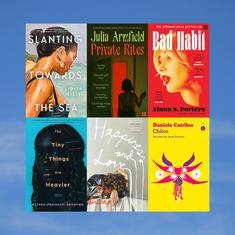Those who complain that there aren’t enough documentaries around will be silenced by the number of titles that are being shown at the Mumbai International Film Festival this year: 825.
The bi-annual showcase of documentaries, short films and animation that is organised by the Films Division kicks off on January 28 with screenings at the FD’s headquarters on Peddar Road in south Mumbai and two more venues within walking distance. “We got a very good response to the festival, and have added new categories, such public safety awareness films,” said Mukesh Sharma, the Director General of Films Division. “MIFF is a very important part of the documentary scene, and there is a great deal of variety here.”
Here is a list, by no means exhaustive, of 35 highlights from the sprawling festival, which includes Films Divison’s in-house titles, independent productions, and documentaries from around the world.
One of the festival’s big-ticket titles is Joshua Oppenheimer’s The Look of Silence, the sequel to The Act of Killing, which interviewed men who were responsible for the deaths of Communist sympathisers in Indonesia in 1965 and ’66. The Act of Silence meets families of the survivors.
Vic Sarin’s The Boy from Greita highlights the severe stigma faced by people afflicted with albinism in Tanzania. In Still Here Already There, Roswitha Ziegler confronts her husband’s losing battle with cancer. Kesang Tseten’s Castaway Man investigates the disappearance of Nepalese intellectual Dor Bahadur Bista. In Agnieszka Zwiefka’s The Queen of Silence, a hearing impaired Roma girl explores her surroundings through dance. Her favourite pick-me-up: Bollywood songs.
Lyari Notes is an Indo-Pak collaboration that examines the indie music scene in Karachi through the efforts of four girls from a troubled neighbourhood to learn music. Another Indo-Pak collaboration is Among the Believers, by Hemal Trivedi and Mohammed Naqvi, which looks at the rise of Islamist ideology in Pakistan.
A German father-son pair pay tribute to Mumbai’s single-screen cinemas and the dying art of hand-painted posters in Original Copy. Farida Pacha’s stunning My Name is Salt captures the harsh production cycle of salt in the Kutch desert. With This Ring is a Canadian documentary on pugilist Mary Kom and members of the Indian Women’s National Boxing Team.
Torsha Banerjee’s National Award-winning Tender is the Sight is about a blind teenager’s negotiation of his environment. Sanju Surendran’s Kapila follows a young artist who is learning Kutiyattam, the ancient performance style.
Renjith Kumar’s topical film 18 Feet studies, through the folk music band Karinthalakkoottam, the stigma of untouchability. In Call From The Other Shore, poet Anwar Ali makes his debut with a documentary on Attoor Ravi Varma, the modernist Malayalam poet. Amit Datta’s Even Red Can Be Sad is a biographical documentary on the abstract painter Ram Kumar. In Nirmal Chander’s The Face Behind the Mask, Shashadhar Acharya, a fifth-generation Chhau dancer, comes alive through his dance. PN Ramachandra’s Lohit Diary investigates the scourge of opium addiction and attempts to address the problem in Arunachal Pradesh.
Tuhinabha Majumdar’s Aamaar Katha: The Story of Binodini explores the life and times of the nineteenth-century actress through her writings. Altaf Mazid’s The Broken Song uncovers an oral tradition of the Ramayana, called Sabil Alun, which is prevalent among the Karbi tribe in Assam. Manipuri filmmaker Haobam Paban Kumar’s Phum Sang studies the ecological damage to the Lohtak freshwater lake.
In Namma Metro, Gautam Sonti and Usha Rao lay bare the havoc wreaked in Bengaluru by the Metro project. Nakul Singh Sawhney’s Muzaffarnagar Baaqi Hai exposes the communal polarisation that resulted in riots between Jats and Muslim in the Uttar Pradesh town in 2014. Tarun Bharatiya’s Brief Life of Insects explores the links between cultivation practices and music in Meghalaya.
Joshy Joseph’s A Poet, A City & A Footballer is about filmmaker Goutam Sen, Kolkata, and the legendary PK Banerjee. Indian New Wave filmmaker Girish Kasarvalli regards the works of writer UR Ananthamurthy in Anathamurthy: Not a Biography But a Hypothesis.
Naresh Bedi, the acclaimed wildlife documentary photographer and filmmaker, will be re-introduced to a new generation of cinephiles through a retrospective. The titles include Cherub in the Mist, about a pair of red panda siblings. There are also films by the late German experimental filmmaker Harun Farocki, including Images of the World and the Inscription of War, a meditation on the inability of Allied pilots during WWII to realise that the industrial plant that they were capturing on film from up in the air was actually next to a concentration camp. A package of newsreels produced by Wadia Movietone is also on the list, including films on Mallika Pukhraj, Subhash Chandra Bose, and Kumar Gandharva.
Filmmaker Don Askarian uses experimental language to explore the history and culture of his native Armenia. The package on Askarian includes Komitas, a biography of the Armenian monk and composer that also folds in the genocide of Armenians by Turkey in the early 1900s.
A selection of productions by the Public Service Broadcasting Trust includes The Hope Doctors, about medical clowning, and My Scared Glass Bowl, a look at the premium placed on virginity in Indian society.
There are also packages from festivals around the world, including Afghanistan, DOK Leipzig, Leiria and Berlin. Look out for the extremely relevant Land in Sight, about asylum seekers in Germany, Vergiss Me Nicht, a personal film about coping with Alzheimer’s, Kamakura, described as an animated haiku, and Il Fattorre Umano, in which Italian photographer Tano D’Amico explores his political involvement with people’s movements.
To register, see www.miff.in










